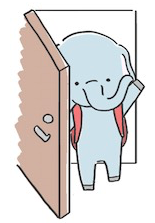日本旅行をもっと楽しく、そして現地の人とより良い関係を築くために、今回は「日本での食事マナー」についてご紹介します。日本では食事は単なる栄養補給ではなく、感謝や礼儀を大切にする文化の一部です。以下のポイントを参考に、気持ちの良い食事体験を楽しんでください。
食事マナー 11のポイント
1. 「いただきます」「ごちそうさまでした」を言いましょう
食べる前には「いただきます」、食べ終わったら「ごちそうさまでした」と挨拶しましょう。感謝の気持ちを表す大切な言葉です。
2. 店内では静かに話すのが基本
レストランでは周囲の人の迷惑にならないよう、落ち着いた声で会話をしましょう。
3. 食事中の電話は控えましょう
食卓での通話はマナー違反とされることがあります。必要な場合は外で話しましょう。
4. お箸の使い方に注意
箸で食べ物を突き刺す・振り回す・なめるといった行為はNG。また、ご飯に箸を立てて刺すのは日本では不吉な行為とされます。
5. 食器は正しく持ちましょう
小さな器(ご飯茶碗や味噌汁椀)は手に持ってOK。大きな皿や丼はテーブルに置いたままが基本です。
6. ラーメンやそばはすする音を立ててもOK
日本では麺類をすする音は自然とされます。ただし、クチャクチャと咀嚼音を立てるのは避けましょう。
7. 大皿料理は取り箸を使う
みんなで分けて食べる料理には、料理を取り分けるための専用の箸(取り箸)を使いましょう。ない場合は、箸の反対側を使うか、店員さんに頼みましょう。
8. お酒を注ぐときは配慮を
自分で自分のグラスに注ぐより、周囲に注ぎ合うのが礼儀とされています。
9. チップは必要ありません
日本ではチップの習慣がなく、サービス料は料金に含まれています。
10. 食べきれる量を注文する
残さず食べることは、作ってくれた人への感謝の気持ちを表すことにもつながります。無理せず完食できる量を注文しましょう。
11. お水やお茶は無料です
多くの飲食店では、冷たい水や温かいお茶を無料で提供しています。遠慮なくどうぞ!
旅行中のちょっとしたマナーの積み重ねが、素敵な思い出に繋がります。

sign up for the Japanese-Online Newsletter
__..-・**・-..__..-・**・-.._ あいうえお かきくけこ さしすせそ たちつてと なにぬねの はひふへほ まみむめも やいゆえよ らりるれろ わゐうゑを ん __..-・**・-..__..-・**・-.._
#JapaneseOnline #LearningJapanese #FreeJapaneseLessons #JapaneseVideoLearning #JapaneseAnime #Anime #JapaneseFood #Bloguru
食事マナー 11のポイント
1. 「いただきます」「ごちそうさまでした」を言いましょう
食べる前には「いただきます」、食べ終わったら「ごちそうさまでした」と挨拶しましょう。感謝の気持ちを表す大切な言葉です。
2. 店内では静かに話すのが基本
レストランでは周囲の人の迷惑にならないよう、落ち着いた声で会話をしましょう。
3. 食事中の電話は控えましょう
食卓での通話はマナー違反とされることがあります。必要な場合は外で話しましょう。
4. お箸の使い方に注意
箸で食べ物を突き刺す・振り回す・なめるといった行為はNG。また、ご飯に箸を立てて刺すのは日本では不吉な行為とされます。
5. 食器は正しく持ちましょう
小さな器(ご飯茶碗や味噌汁椀)は手に持ってOK。大きな皿や丼はテーブルに置いたままが基本です。
6. ラーメンやそばはすする音を立ててもOK
日本では麺類をすする音は自然とされます。ただし、クチャクチャと咀嚼音を立てるのは避けましょう。
7. 大皿料理は取り箸を使う
みんなで分けて食べる料理には、料理を取り分けるための専用の箸(取り箸)を使いましょう。ない場合は、箸の反対側を使うか、店員さんに頼みましょう。
8. お酒を注ぐときは配慮を
自分で自分のグラスに注ぐより、周囲に注ぎ合うのが礼儀とされています。
9. チップは必要ありません
日本ではチップの習慣がなく、サービス料は料金に含まれています。
10. 食べきれる量を注文する
残さず食べることは、作ってくれた人への感謝の気持ちを表すことにもつながります。無理せず完食できる量を注文しましょう。
11. お水やお茶は無料です
多くの飲食店では、冷たい水や温かいお茶を無料で提供しています。遠慮なくどうぞ!
旅行中のちょっとしたマナーの積み重ねが、素敵な思い出に繋がります。
Japanese Table Manners: 11 Tips You Should Know
To make your trip to Japan even more enjoyable and help build stronger connections with locals, here are some essential Japanese dining etiquette tips. In Japanese culture, food is more than just sustenance; it reflects deep-rooted traditions, with a strong cultural emphasis on gratitude and respect. Keep these tips in mind and enjoy a more pleasant dining experience.
11 Japanese Table Manners
1. Say thanks before and after your meal
Before eating, say itadakimasu (“I humbly receive”), and after finishing your meal, say gochisousama deshita (“Thank you for the meal”). These expressions show your appreciation for the food and those who prepared it.
2. Keep your voice down in restaurants
Speak quietly when dining out to avoid disturbing others. Maintaining a calm and respectful atmosphere is considered polite.
3. Avoid talking on the phone during meals
Taking phone calls while eating is considered impolite. If you really need to make or answer a call, step outside the dining area.
4. Mind your chopstick manners
Don’t stab food, wave chopsticks around, or lick the tips of your chopsticks. Also, never stick your chopsticks upright into a bowl of rice—Japanese culture associates it with funeral rituals, so it’s considered bad luck.
5. Hold dishes properly
It’s fine to hold up small dishes, like rice or miso soup bowls, in your hands, but you should keep larger plates and bowls on the table while you eat.
6. It’s okay to slurp noodles
In Japan, slurping noodles like ramen or soba is perfectly acceptable and even seen as a way to enjoy them. However, try to avoid making loud chewing sounds.
7. Use serving utensils for shared dishes
Use the serving chopsticks provided (called tori-bashi) to take food from the communal plate. If no serving chopsticks are provided, use the other end of your chopsticks or ask the staff for serving utensils.
8. Be considerate when pouring alcohol
Rather than pouring a drink for yourself, it’s customary to pour drinks for each other into glasses.
9. No tipping necessary
Tipping is not customary in Japan. They usually include service charges in the bill, so they sometimes consider offering a tip as rude.
10. Only order what you can finish
Finishing your plate is an act of gratitude towards the ingredients and the people who made your meal. Only order a portion you can comfortably finish.
11. Water and tea are complementary
Most restaurants offer complimentary water or hot tea. Feel free to help yourself.
You can create more meaningful and memorable travel experiences by being mindful of local manners.
11 Japanese Table Manners
1. Say thanks before and after your meal
Before eating, say itadakimasu (“I humbly receive”), and after finishing your meal, say gochisousama deshita (“Thank you for the meal”). These expressions show your appreciation for the food and those who prepared it.
2. Keep your voice down in restaurants
Speak quietly when dining out to avoid disturbing others. Maintaining a calm and respectful atmosphere is considered polite.
3. Avoid talking on the phone during meals
Taking phone calls while eating is considered impolite. If you really need to make or answer a call, step outside the dining area.
4. Mind your chopstick manners
Don’t stab food, wave chopsticks around, or lick the tips of your chopsticks. Also, never stick your chopsticks upright into a bowl of rice—Japanese culture associates it with funeral rituals, so it’s considered bad luck.
5. Hold dishes properly
It’s fine to hold up small dishes, like rice or miso soup bowls, in your hands, but you should keep larger plates and bowls on the table while you eat.
6. It’s okay to slurp noodles
In Japan, slurping noodles like ramen or soba is perfectly acceptable and even seen as a way to enjoy them. However, try to avoid making loud chewing sounds.
7. Use serving utensils for shared dishes
Use the serving chopsticks provided (called tori-bashi) to take food from the communal plate. If no serving chopsticks are provided, use the other end of your chopsticks or ask the staff for serving utensils.
8. Be considerate when pouring alcohol
Rather than pouring a drink for yourself, it’s customary to pour drinks for each other into glasses.
9. No tipping necessary
Tipping is not customary in Japan. They usually include service charges in the bill, so they sometimes consider offering a tip as rude.
10. Only order what you can finish
Finishing your plate is an act of gratitude towards the ingredients and the people who made your meal. Only order a portion you can comfortably finish.
11. Water and tea are complementary
Most restaurants offer complimentary water or hot tea. Feel free to help yourself.
You can create more meaningful and memorable travel experiences by being mindful of local manners.
sign up for the Japanese-Online Newsletter
__..-・**・-..__..-・**・-.._ あいうえお かきくけこ さしすせそ たちつてと なにぬねの はひふへほ まみむめも やいゆえよ らりるれろ わゐうゑを ん __..-・**・-..__..-・**・-.._
#JapaneseOnline #LearningJapanese #FreeJapaneseLessons #JapaneseVideoLearning #JapaneseAnime #Anime #JapaneseFood #Bloguru

